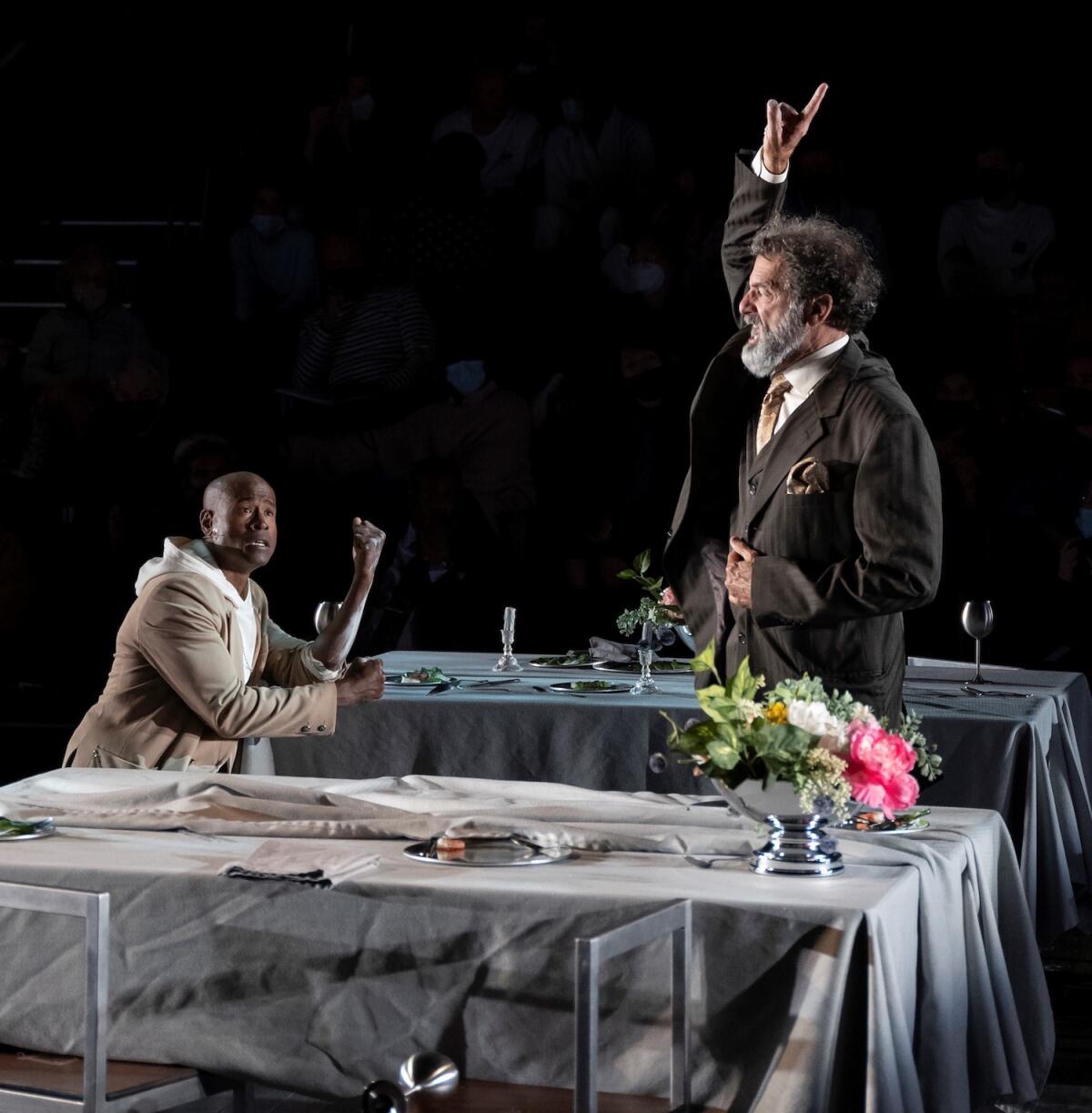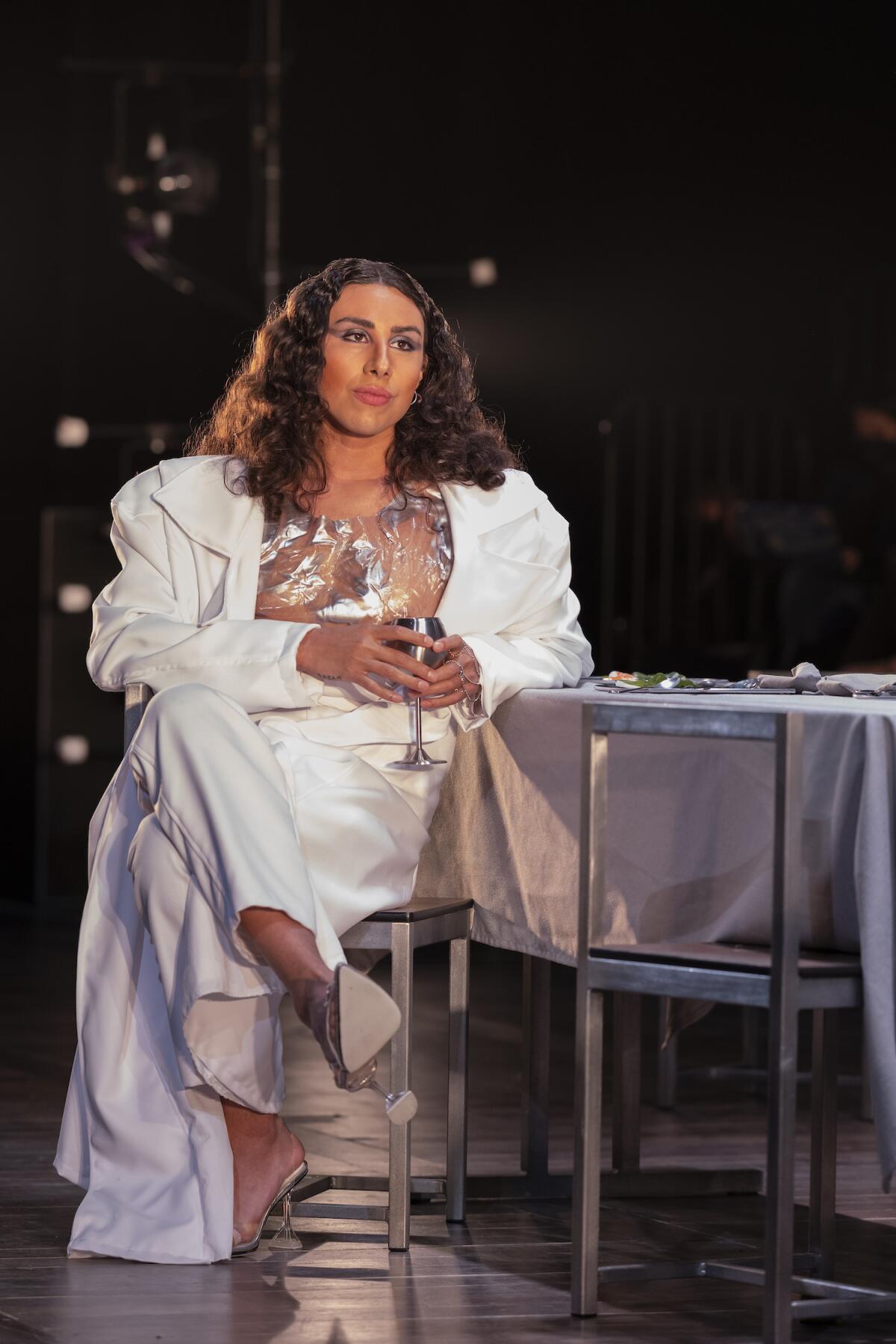In striving to be modern, the Wallis makes a mockery of ‘King Lear’

- Share via
Every so often in the career of a theater critic, a production becomes a crime scene and the critic is thrust into the role of medical examiner to determine how the victim died.
The bloody mess at the Wallis Annenberg Center for the Performing Arts, where a lunatic production of “King Lear” is running riot, is shocking to the sensibility. Shakespeare’s play is put in a Cuisinart. Characters are cut, lines reallocated, scenes rearranged. The problem isn’t that liberties are taken but that there’s so little dramatic sense behind the maneuvers.
Director John Gould Rubin bears much of the blame for the ensuing farrago, though no one could accomplish this level of confusion alone. In striving to make the play seem new, he renders it incoherent. His production is bursting with ideas yet unable to sustain a thought.
Scenes of devastating floods and fires flash onto two rectangular video panels that face each other from opposite sides of the stage. The production transports us to a modern age in which texting and video calling are standard forms of communication, but there’s something superficial in the appeal to relevance. Yes, “Lear” imagines an apocalypse hastened by humanity’s misdeeds. But the incorporated footage of climate disasters has the look and feel of wallpaper.
The show is billed as “The Wallis’ Production of Joe Morton as ‘King Lear,’’’ which is an odd grammatical construction. But what’s even stranger is the way Morton’s Lear recedes into the ensemble, becoming a supporting player in his own tragedy.
Morton brings a refreshing comic spryness to Lear, playing him not as a doddering old man but as a vivacious, scampering jokester who expects to be treated as the life of the party. When his cruel daughters turn on him after obtaining their inheritance, he grows petulant and vindictive, like a once-famous actor denied a table at his favorite A-list restaurant.
The performance brings to mind Morton’s portrayal of trailblazing comedian Dick Gregory in “Turn Me Loose.” In fact, the Wallis production of Gretchen Law’s play, which Rubin directed, is where the idea of this “King Lear” was born.
Paul Crewes, who was the artistic director at the time, serves as creative producer on what is his swan song at the Beverly Hills theater. It’s an unfortunate way to go out, but hardly surprising for a venue that has yet to define its place and purpose in L.A.’s performing arts ecosystem.
The ambition behind this so-called radical reinvention of “King Lear” is worthy of praise, but the Wallis has bitten off more than it can artistically chew. The result is a muddle that should have been limited to an invitation-only workshop.

Some of the finest Shakespeare I’ve seen has come courtesy of auteurs. Ingmar Bergman’s “Hamlet” and Ivo van Hove’s “Kings of War,” a mashup of history plays, effectively rewrote the dramas through their stagings. But Shakespeare was illuminated in the process.
The directorial vision at the Wallis is too sputtering to rework “King Lear.” Why not commission a free adaptation of the play? A model for this would be Jamie Lloyd’s sensational production of Edmond Rostand’s “Cyrano de Bergerac” in a new version by playwright Martin Crimp that has been the toast of New York since it opened last month at the Brooklyn Academy of Music.
At the very least, Rubin’s production could use a new title. “Edmund” wouldn’t seem amiss for a production that starts with this dashing villain seizing center stage to deliver a soliloquy on the comic injustice of being born a bastard. Dressed in the sporty get-up of a fashionable jockey, Rafael Jordan’s Edmund has the air of a professional athlete who couldn’t care less about the scandals piling up in his wake.
Rubin splices Edmund’s speech into a stage montage that leads directly into Lear’s ceremonial division of the kingdom. The atmosphere is a multimedia swirl, but it’s the changes in dramatis personae that make the production initially hard to track.
Kent is missing in action, so Gloucester (Mark Harelik), Edmund’s father, now makes saucy remarks to France (Zachary Solomon), one of Cordelia’s suitors, about his illegitimate son. I wasn’t clear at first that this was France because the character absorbs some of the lines of Burgundy, the other French rival for Cordelia’s hand who chooses not to marry after her father cuts her off.
Burgundy is excised, which is no big deal compared with the absence of loyal Kent. In the opening scene, when Lear pitches his fit at Cordelia (River Gallo) for not publicly pronouncing her filial adoration, Goneril (Emily Swallow), one of Cordelia’s self-seeking sisters, incongruously assumes Kent’s place and comes between Lear and his wrath.
This is a blip, but it’s a sign of the sloppy storytelling to come. Rubin is reacting to the play in bold strokes and can’t be bothered with such pesky details as overarching plot points and character fundamentals.
The attention-grabbing costumes by X. Hill add another layer of bafflement. Tragedy comes dressed as outlandish comedy.
When Lear encounters Gloucester late in the play, he dons an ensemble of what looks like recycling bags. Gloucester conceals his gouged-out eyes behind a pair of plastic flower sunglasses.
Goneril and her equally malevolent sister Regan (Brie Eley) are kitted out like rejected cast members of “The Real Housewives of Beverly Hills.” Tasked with torturing Gloucester in a production that excludes their husbands, these evil daughters take out the old man’s eyes with their stiletto heels.
Beyond playing France, Solomon tackles the slippery role of Edgar, who ditches a pajama-patterned suit for green makeup and fuchsia drag when forced to go undercover as Poor Tom. The finery he breaks out when Edgar returns at the end to challenge Edmund to a duel is so ludicrously foppish I wondered if a young Liberace might have been the design inspiration.

River Gallo, a nonbinary actor who uses the pronouns they/them, plays both Cordelia and the Fool in a white ensemble that looks like something that might have been derived from Joan Collins’ wardrobe for the 1980s television series “Dynasty.” Cordelia and the Fool have no scenes in common, so there’s no problem in casting them with the same actor.
Indeed, there’s some speculation that the earliest productions of “King Lear” engaged in the same double casting. But Gallo, earnestly mugging throughout, doesn’t effectively differentiate between the two characters.
One of the problems — and it’s an ensemble-wide issue — is that Shakespeare’s poetry sounds as if it’s being transmitted by a karaoke machine. Line interpretations are all askew. The actors have a tendency to jump on particular words in a speech, adding explosive emphasis that rarely sheds any light.
The goal of the production seems to be liveliness. But untethered to meaning, the effect of all this over-emoting is numbing. The actors take a seat in the audience when not directly involved in a scene. Swallow was sitting near me at one point, and I was tempted to ask her what she was making of all this craziness. I was detached, incredulous and wondering how I could care so little about characters who are suffering so much.
The fake crying that accompanied the intensifying agony (Solomon’s Edgar is like a wandering wail-track) was maddening. If it weren’t for the soothing drone of the soundscape created by Danny Erdberg and Ursula Kwong-Brown, I fear my own sanity would have collapsed along with Lear’s.
Christopher Barreca’s scenic design, sharpened into focus by Stephen Strawbridge’s lighting, is organized around a set of banquet tables that, by the end, are flipped over, with their contents strewn across the floor. By the final act, Keith Skretch’s projections are flashing imagery directly onto the audience, a section of which is seated behind the set.
When Morton’s Lear enters at the end howling at Cordelia’s death, Gallo follows behind but whether as Cordelia or the Fool is anyone’s guess. If the point of “King Lear” is to communicate universal chaos, then this production succeeds beyond measure.
'King Lear'
Where: The Wallis Annenberg Center for the Performing Arts, 9390 N. Santa Monica Blvd., Beverly Hills
When: 7:30 p.m. Wednesdays-Fridays, 2 and 7:30 p.m. Saturdays, 2 and 7 p.m. Sundays, Tickets $39-$125
Info: (310) 746-4000, thewallis.org/lear
Running time: 3 hours (with one intermission)
COVID protocol: Proof of full vaccination is required or negative PCR test result within 48 hours or a verifiable Antigen test within 24 hours. Masks are required at all times. (Check website for changes.)
More to Read
The biggest entertainment stories
Get our big stories about Hollywood, film, television, music, arts, culture and more right in your inbox as soon as they publish.
You may occasionally receive promotional content from the Los Angeles Times.











